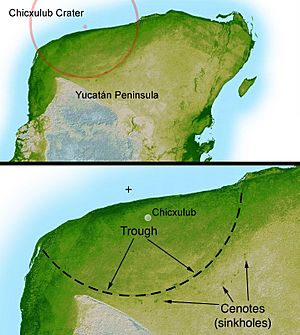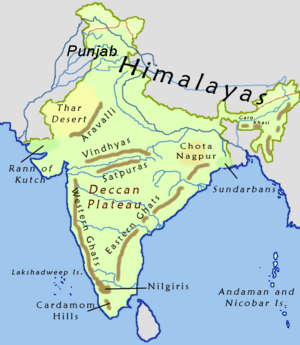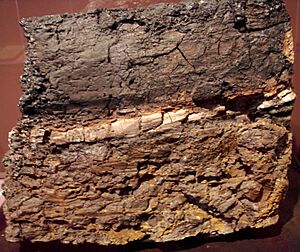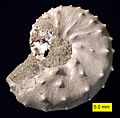K/T extinction event facts for kids
The Cretaceous–Paleogene extinction event was a huge event that happened about 66 million years ago. It's often called the K/Pg event or K/T extinction event for short. This is the famous time when the dinosaurs disappeared at the end of the Cretaceous period.
This event was a massive mass extinction where many types of animals and plants died out. It marks the end of the Mesozoic Era (the "Age of Dinosaurs") and the start of the Cainozoic Era (the "Age of Mammals").
Contents
What Happened During the K/Pg Extinction?

Dinosaur fossils are only found below the K/Pg boundary layer in rocks. This tells us that dinosaurs became extinct right before or during this event. Many other creatures also died out. These included large marine reptiles like Mosasaurs and plesiosaurs, flying reptiles called pterosaurs, and many kinds of plants and small sea animals (invertebrates).
Some groups of mammals and birds survived the event, even though some of their species also died. The animals that made it through then spread out and developed into many new types during their later evolution. This is called adaptive radiation.
What Caused the K/Pg Extinction?
The K/Pg extinctions happened very suddenly and affected life all over the world. This means they must have been caused by something very sudden and powerful. Scientists have suggested a few main ideas. These include one or more huge asteroid or meteor impacts, or a lot of volcanic activity.
How quickly animals died out around the world is an important clue. Patterns found in rocks also give us hints about the causes. For example, there are several impact craters and signs of massive volcanic activity in the Deccan Traps in India. These are dated to about the same time as the extinctions. Such impacts and volcanoes would have blocked sunlight, making it hard for plants to grow through photosynthesis. This would have messed up Earth's ecology (the balance of living things).
The most widely supported idea is that a giant meteorite hitting the Yucatan Peninsula was the main cause of the extinction at the end of the Mesozoic Era.
Giant Craters from Impacts

Several impact events happened around the time of the Cretaceous/Tertiary boundary. The most famous is the Chicxulub crater in Mexico. Other craters include the Boltysh crater in Ukraine, the Silverpit crater in the North Sea, and the Shiva crater off the coast of western India.
The Shiva crater is a structure found on the sea floor under the continental shelf in the Indian Ocean, west of Mumbai, India. It was named by a scientist named Sankar Chatterjee after Shiva, a Hindu god known for destruction and renewal.
Related pages
Images for kids
-
Discoscaphites iris ammonite from the Owl Creek Formation (Upper Cretaceous), Owl Creek, Ripley, Mississippi
-
Kronosaurus Hunt, an artwork by Dmitry Bogdanov in 2008. Large marine reptiles, including plesiosaurians such as these, became extinct at the end of the Cretaceous.
-
Tyrannosaurus was among the dinosaurs living on Earth before the extinction.
-
The K–Pg boundary exposure in Trinidad Lake State Park, in the Raton Basin of Colorado, shows an abrupt change from dark- to light-colored rock.
-
Radar images show the 180 km (112 mi)-wide ring of the Chicxulub crater.
-
Artistic impression of the asteroid slamming into tropical, shallow seas of the sulfur-rich Yucatán Peninsula in what is today Southeast Mexico. The aftermath of this immense asteroid collision, which occurred approximately 66 million years ago, is believed to have caused the mass extinction of dinosaurs and many other species on Earth. The impact spewed hundreds of billions of tons of sulfur into the atmosphere, producing a worldwide blackout and freezing temperatures which persisted for at least a decade.
-
An artist's rendering of Thescelosaurus shortly after the K–Pg mass extinction. It survived by burrowing, but would soon die of starvation.
See also
 In Spanish: Extinción masiva del Cretácico-Paleógeno para niños
In Spanish: Extinción masiva del Cretácico-Paleógeno para niños












